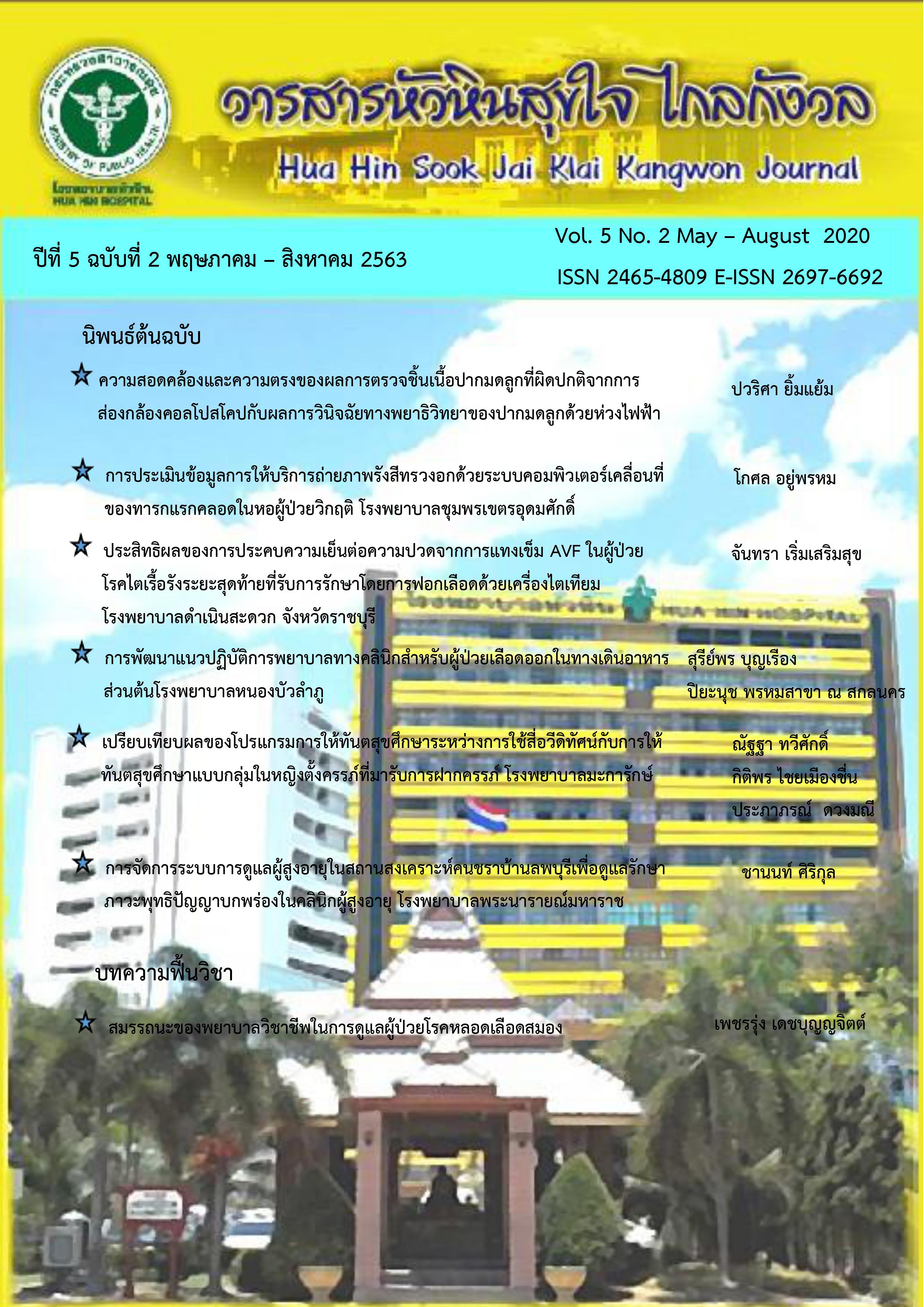Data evaluation of chest radiographic Services in Newborns using a mobile computer system in Neonatal Intensive Care Units, Chumphonkhetudomsak Hospital.
Keywords:
Computed Radiography, Exposure Index, Chest Radiographs in NeonatalAbstract
Abstract
Introduction: Currently, the digital radiography system has replaced traditional screen-film systems due to faster image acquisition, better quality images and safety from a chemical film remover. To provide feedback regarding the proper radiographic techniques, the exposure index (EI) has been used as an international standard. It indirectly suggests whether the appropriate radiation dose has been achieved, which subsequently indicate image quality and radiation exposure to the patient. Excessive use of radiation will be harmful to patients but using a small amount of radiation will reduce the quality of the radiograph which may not be able to diagnose the disease.
Objective: To examine radiographers’ performance regarding EI usage and understanding and evaluate the EI data from chest radiography done by the mobile computer system at Neonatal Intensive Care Units (NICU) in terms of the EI range determined by the manufacturer.
Materials and methods: The study was conducted from January 2016 to December 2019.
The performance of 9 radiographers regarding the organ thickness measurement for the technique setting and determining the (EI) after radiography was recorded and the data of the radiographic index from NICU, Chumphonkhetudomsak Hospital was analyzed.
Results: The study shows that 97.22% of the images had the EI within the range specified by the manufacturer (S-value 200-700), 1.48% were overexposed (S-value>700) indicating insufficient radiation dose to optimize image quality and 1.30% were underexposed (S-value<200) suggesting that the amount of radiation was excessive and there is a tendency to use more radiation. Regarding the performance of the radiographers, 55.56 % did not measure a thickness of the organs before setting the technique and 11.11 % did not review the EI after imaging procedure.
Conclusions: The findings demonstrate that the majority of radiographic images have the EI. 97.22% with.in the normal range. However, it is necessary for a radiographer to use the EI to optimize the quality of radiographic image at the lowest possible radiation dose.
Keywords: Computed Radiography, Exposure Index, Chest Radiographs in Neonatal
References
Takaki, T, Takeda, K., Murakami, S., Ogawa, H., Ogawa, M., Sakamoto, M. Evaluation of the effects of subject thickness on the exposure index in digital radiography. Radiological physics and technology, 2016;9(1), 116-120.
Wouter JHV, Lucia JMK, Jacob G: Dose and perceived image quality in chest radiography. Eur Radiol 72:209-217, 2009
International Atomic Energy Agency (IAEA): Optimization of the radiological protection of patients undergoing radiography, fluoroscopy and computed tomography. Vienna: IAEA, 2004
European Commission: Guidance on diagnostic reference levels for medical exposures. Radiation protection 109. Luxembourg: Office for Official Publications of the European Communities,1999
Hart D, Hillier MC, Wall BF: Doses to patients from medical X ray examinations in the UK 2000 review. Oxford: National Radiological Protection Board Publication, 2002
Gray JE, Archer BR, Butler PF, et al: Reference values for diagnostic radiology: application and impact. Radiology 235:354–358, 2005
International Commission on Radiological Protection (ICRP): Managing patient dose in digital radiology. ICRP Publication 93. Annals of the ICRP 34, No. 1. Oxford: Pergamon Press,2004
Willis CE. Computed radiography: a higher dose? Pediatr Radiol 2002; 32:745–750
Sonoda M, Takano M, Miyahara J, Kato H. Computed radiography utilizing scanning laser stimulated luminescence. Radiology 1983; 148:833–838
Willis CE, Slovis TL. The ALARA concept in pediatric CR and DR: dose reduction in pediatric radiographic
exams—a white paper conference executive summary. Pediatr Radiol 2004; 34(suppl3):S162–S164
Aichinger H, Dierker J, Joite-Barfuß S, S€abel M. Chapter 9: Image Quality and Dose. In: Aichinger H, Dierker J, Joite-Barfuß S, S€abel M (ed). Radiation Exposure and Image Quality in X-Ray Diagnostic Radiology: Physical Principles and Clinical Applications, 2nd edn. Springer-Verlag, Berlin, Heidelberg, 2012; 87.
Cohen MD, Cooper ML, Piersall K, Apgar BK. Quality assurance: Using the exposure index and the deviation index to monitor radiation exposure for portable chest radiographs in neonates. Pediatr Radiol 2011; 41: 592-601.
Gibson DJ, Davidson RA. Exposure creep in computed radiography: A longitudinal study. Acad Radiol 2012; 19: 458–62.
Shepard SJ, Wang J, Flynn M, et al. An exposure indicator for digital radiography. College Park (MD): American Association of Physicists in Medicine; July 2009; 92 p. Report No: 116.
Andriole KP, Ruckdeschel TG, Flynn MJ, et al. ACRAAPM-SIIM practice guidelines for digital radiography. J Digit Imaging 2013; 26: 26–37.
Seibert JA, Morin RL. The standardized exposure index for digital radiography: An opportunity for optimization of radiation dose to the pediatric population. Pediatr Radiol 2011; 41: 573–81.
International Electrotechnical Commission. Medical electrical equipment – Exposure index of digital X-ray imaging systems- Part 1: Definitions and requirements for general radiography. IEC, Geneva, Switzerland, 2008 International standard 62494-1.
Neitzel U. The Exposure Index and its Standardization 2006 [Internet]. Philips Medical Systems, Hamburg, Germany; Available from: http://www.dimond3.org/Trier_2006/Exposure_Index_Standardization.pdf [Accessed 2013 November 18].
Goske MJ, Charkot E, Herrmann T, et al. Image gently: Challenges for radiologic technologist when performing digital radiography in children. Pediatr Radiol 2011; 41:611–9.
Don S (2004) Radiosensitivity of children: potential for overexposure in CR and DR and magnitude of doses in ordinary radiographic examinations. Pediatr Radiol 34(Suppl 3):S167–172,discussion S234-241
Uffmann M, Schaefer-Prokop C (2009) Digital radiography: the balance between image quality and required radiation dose. Eur J Radiol 72:202–208
Vaño E, Fernández JM, Ten Ignacio J et al (2007) Transition from screen-film to digital radiography: evolution of patient radiation doses at projection radiography. Radiology 243:461–466
International Commission on Radiological Protection (2004) Managing patient dose in digital radiology: a report of the International Commission on Radiological Protection. Ann ICRP34:1–73
Mothiram, U., Brennan, P. C., Lewis, S. J., Moran, B., Robinson, J. (2014). Digital radiography exposure indices: A review.Journal of medical radiation sciences, 61(2), 112-118.
Zhang, M., & Chu, C. (2012).Optimization of the radiological protection of patients undergoing digital radiography.Journal of digital imaging, 25(1), 196-200.
Downloads
Published
How to Cite
Issue
Section
License
บทความที่ได้รับการตีพิมพ์ในวารสารหัวหินเวชสาร เป็นลิขสิทธิ์ของโรงพยาบาลหัวหิน
บทความที่ลงพิมพ์ใน วารสารหัวหินเวชสาร ถือว่าเป็นความเห็นส่วนตัวของผู้เขียนคณะบรรณาธิการไม่จำเป็นต้องเห็นด้วย ผู้เขียนต้องรับผิดชอบต่อบทความของตนเอง







